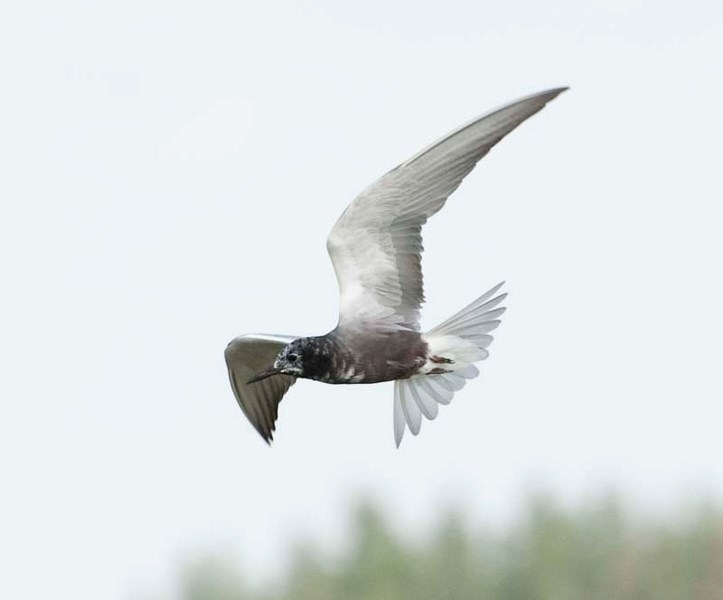A local wetland boardwalk is once again off-limits due to some feisty terns.
Visitors to the John E. Poole wetland boardwalk might have noticed some black terns doing strafing runs on them in recent weeks.
Like last year, these gull-like birds are nesting near the boardwalk and defending their eggs aggressively, said Matthew Wheatley, conservation biologist with Alberta Tourism, Parks and Recreation.
The province closed the boardwalk Wednesday as a result.
“They get quite aggressive, so we like to give them a bit of a break.”
Every moment spent defending their nest from pedestrians is one that the birds don’t spend incubating their eggs, Wheatley explained.
The boardwalk will likely stay closed for at least three weeks, Wheatley said. Parks officials will monitor the site to determine when it’s safe to reopen.
“When (the birds) start simmering down, we’ll reopen it up.”
Questions on the closure should go to Alberta Parks at 780-960-8170.
Environmental groups like BLESS will have a place after all in the Sturgeon River watershed group.
City council signed off on the terms of reference for the steering committee of the Sturgeon River Watershed Alliance Monday.
This was a largely symbolic move that reaffirms the city’s support of the group, said Coun. Gilles Prefontaine, who is also the group’s chair.
“St. Albert has been pretty instrumental and very passionate about the stewardship of the Sturgeon River,” he said, and the city wants to take a leading role in this organization.
The terms of reference spell out the group’s organization. The steering committee is to meet at least twice a year, and consists entirely of elected officials.
These officials will be the political link needed to put the group’s ideas into action, Prefontaine said. Officials can enrol as active (voting) or informed (non-voting) members depending on their ability to participate in the group. Decisions will be made by consensus where possible and a simple majority vote where not.
The group will also be backed by a technical advisory committee of administrators and representatives from First Nations, industry, the province, educational institutions and non-governmental organizations.
“The technical action committee is the one who’s really doing the heavy lifting in terms of the activities and the work,” Prefontaine said.
The group’s membership would fluctuate depending on the standing committee’s priorities, he continued.
“In order for us to be effective, we can’t engage everyone all the time,” he said, speaking in council.
Local groups such as the Big Lake Environmental Support Society would “absolutely” be included in this group, he added.
The watershed group will next meet this fall to determine its work-plan for the year.
Anglers should belay their bait-dumping ways this summer to keep invasive earthworms from ravaging Alberta’s forests, says a local scholar.
University of Alberta graduate Erin Cameron sent out a reminder to fisherpeople this week to not dump unwanted earthworms outside of city limits.
“They’re not a native species and they’re spreading across a lot of Canada.”
Europeans brought over the ubiquitous earthworm in plants and soil during the early days of settlement, said Cameron, who is now pursuing her postdoctorate in ecology in Finland.
While Alberta does have a handful of native earthworms, most of them were wiped out in the last ice age. About 14 non-native earthworm species have been discovered in the province so far, reports the Alberta Worm Invasion Project website.
While earthworms are great in gardens and urban areas as they aerate soil, they’re harmful in forests, as they eat and mix up the thick leaf layer that many species depend upon to live, Cameron said. U.S. and Quebec research suggests that earthworms can reduce the diversity of bugs and plants found in a forest understory once introduced and cause some rare plants to go locally extinct.
“There’s no known way of removing them once they’ve invaded,” Cameron said of earthworms, but they also invade slowly, with their territory moving just 10 metres a year on average. That makes humans extremely important when it comes to their rate of spread.
Her research suggests the worms have yet to invade northern Alberta in force. While about 70 per cent of the areas near boat launches she surveyed had them, just 10 per cent of forest sites contained earthworms.
Cameron hopes local students and nature lovers will help her track the spread of these worms using the U of A’s Worm Tracker app. The app asks users to photograph and measure any earthworms they find and list their locations.
“The main thing people can do is not dump their bait,” Cameron said.
Unused worms should be disposed of in the trash or garden within city limits. ATVs and other vehicles should also be thoroughly cleaned before leaving a site to avoid tracking worm eggs out of an area.
Visit worms.biology.ualberta.ca for more on the project.




